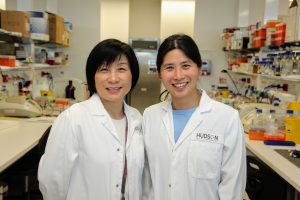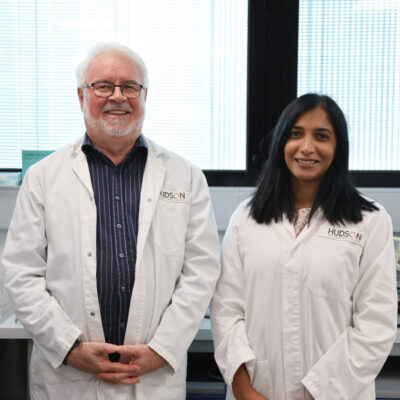When the good guy goes bad: placenta and preeclampsia
By Hudson Institute communications
Over-production of an enzyme created by the placenta may be a contributing factor to the life-threatening pregnancy condition preeclampsia.
It has long been known that the placenta, which nourishes a baby during pregnancy, has a role in the onset of preeclampsia. However, what its role is and why the condition occurs has not been well understood.
Hudson Institute’s Professor Guiying Nie and Dr Yao Wang have been studying the placenta-produced enzyme, HtrA4, for several years. Through their research, they know that the placenta is the only organ that produces HtrA4, and that the enzyme is released into the maternal blood circulation during pregnancy. They also know that the placenta produces this enzyme in excessively high levels in preeclamptic pregnancies.
This recent pre-clinical study, published in FASEB Journal, found that excessive levels of HtrA4 may interfere with the regulation and function of the cells that line the interior walls of blood vessels, possibly contributing to the development of preeclampsia.
Prof Nie believes that this discovery may pave the way for finding a treatment for preeclampsia.
A life-threatening condition
Prof Nie said, “Preeclampsia is one of the leading causes of death for both mothers and their babies during pregnancy. It’s associated with high blood pressure, swelling, protein in the urine, or malfunction of the kidneys and liver.
“In some women, when preeclampsia sets in, the only option is to deliver the baby prematurely to avoid life-threatening complications.
“There have been no therapeutic advances in the treatment of preeclampsia for a long time, so finding a treatment for these women and their babies is well overdue.”
The enigmatic HtrA4
“There is still a lot we have to learn about HtrA4. We don’t know why the placenta produces it, but it may have a beneficial role when produced in a low amount,” she said.
“In this study we got to the root of how the enzyme in excess physiologically affects a woman’s blood vessels. HtrA4 can inhibit the action of a key regulator of blood vessel cells, called VEGFA.
“When blood vessels stop functioning correctly, it can lead to high blood pressure and other severe health complications.”
Finding a treatment
Prof Nie says the next step in this research is to find a treatment that can moderate the amount of the enzyme present.
“We don’t want to eliminate the enzyme entirely, we just want to bring it to the level of pregnant woman without preeclampsia.
“I am working with my team on developing this treatment, as part of further ongoing research into HtrA4 and preeclampsia.”
Collaborators | Monash University, CSIRO
This research was supported by | National Health and Medical Research Council of Australia (Fellowship and project grant to G.N, and a Dora Lush Biomedical Research Scholarship to Y.W.), the Victorian State Government Operational Infrastructure Scheme, and the National Collaborative Research Infrastructure
In this article
About Hudson Institute
Hudson Institute’ s research programs deliver in three areas of medical need – inflammation, cancer, women’s and newborn health. More
Hudson News
Get the inside view on discoveries and patient stories
“Thank you Hudson Institute researchers. Your work brings such hope to all women with ovarian cancer knowing that potentially women in the future won't have to go through what we have!”





